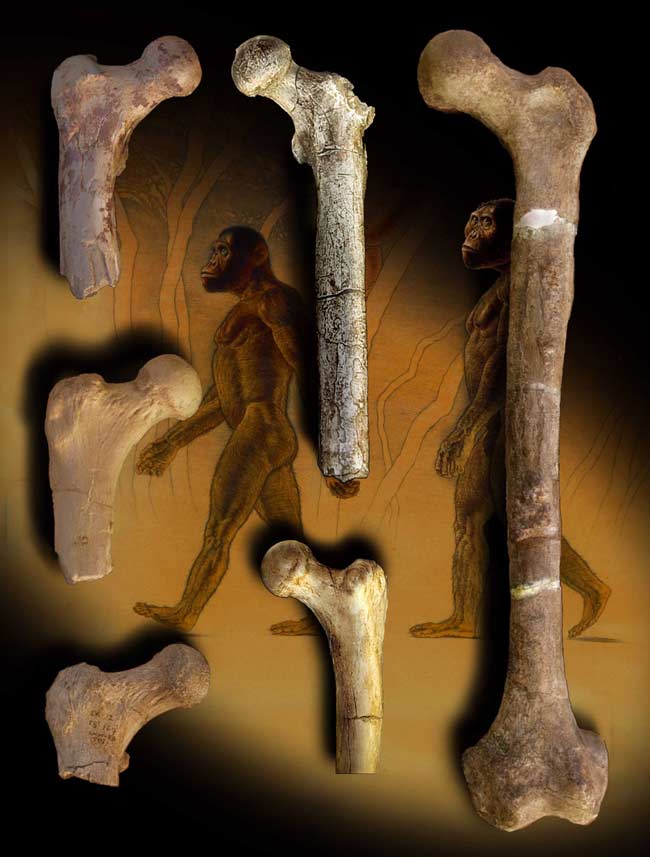New Fossil Is Oldest Upright Walker

A 6 million-year-old early relative of modern humans apparently walked on two feet, pushing back the origins of so-called bipedalism, according to a new study of a fossil found in Kenya.
"I would say at this point it’s the earliest fossil hominin that we can clearly identify as bipedal," said paleoanthropologist William Jungers of Stony Brook University, who conducted a quantitative analysis with Brian Richmond of George Washington University of a fossilized femur bone from the species named Orrorin tugenensis. It is one of the earliest known pre-humans.
The researchers compared the shape of this thigh bone to those of modern humans, apes and other early hominins, including Australopithecus (the species to which the famous "Lucy" fossil belongs). The team determined that the femur bears the signatures of bipedalism, or walking upright on two feet.
The research, funded by the National Science Foundation and Stony Brook and George Washington universities, is detailed in the March 21 issue of the journal Science.
Carol Ward, an anatomist at the University of Missouri-Columbia who was not involved in the research, said the team's findings are significant.
"No detailed study had ever been done on this fossil, and they did a very solid comparative metric analysis," she said.
Debate about tree-climbing
Get the world’s most fascinating discoveries delivered straight to your inbox.
What's special about O. tugenensis, and other early humans that lived between 6 million and 2 million years ago, is that they not only travelled on the ground on two legs but also retained the ability to climb trees, Jungers said.
"These are bipedal walkers that were also using the tress for food, sleeping and escaping from predators," Jungers told LiveScience. The researchers think O. tugenensis was a climber because of a finger bone also found belonging to the species. The finger is curved, Jungers said, a sign that it was used to grasp trees.
Ward said she isn't convinced this species or its later relatives spent a lot of time in trees.
"Everyone agrees they were well-adapted to walking upright on the ground," she said. "People differ on how important tree climbing was. I think we can't say yet. We need more fossils."
Eventually, the ancestors of modern humans completely lost their expert climbing abilities.
"What happens at about 2 million years ago is really fascinating, because you relinquish this very successful body plan, and what emerges is a body plan that's much more similar to yours and mine," Jungers said.
At this point, our ancestors gave up their curved finger bones and gained longer hind legs, perfect for walking long distances and running but not as well suited to scrambling around trees.
The O. tugenensis fossils were discovered in 2000 by a team led by French researchers Martin Pickford and Brigitte Senut. The find was dubbed "Millennium Man."
Pickford and Senut were the first to propose that the species was bipedal, but it wasn't until Jungers' and Richmond's new study that this could be confirmed.
Clarifying the hominin ancestry
The fossils' discoverers had suggested that Orrorin was a direct ancestor of modern humans, with special similarities to us. Jungers and Richmond found that these ancient fossils actually have much more in common with Australopithecus, an extinct early hominin made famous by the discovery of "Lucy." Australopithecus appeared about 4 million years ago, 2 million years after O. tugenensis.
Ward agreed that the new study disproved the hypothesis that Orrorin was a direct modern human ancestor.
"This certainly puts the nail in the coffin on that idea," she said. "They’ve very carefully demonstrated that it looks like Australopithecus."
Both Australopithecus and O. tugenensis were smaller than modern humans and stocky, Jungers said. They had big teeth, projecting faces and small brains, closer to the size of chimpanzee brains than ours.
Though O. tugenensis was not our direct ancestor, it was part of the group of early hominins that eventually gave rise to our genus Homo, as opposed to the related group from which chimpanzees emerged. The study of the Orrorin fossils helps scientists narrow down when humans and chimpanzees split.
"This clearly post-dates that split, so it gives us a minimum date of six million years ago for humans splitting off," Jungers said.
- Timeline of Human Evolution
- Top 10 Missing Links in Human Evolution
- Why We Walk Upright: Beats Being a Chimp



